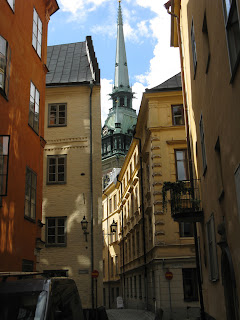Just west of Gamla Stan is Riddarholmen, a small island whose
name translates to The Knights’ Island. This island is a little time capsule of
Swedish history—many of the important events in Swedish history directly affected
and shaped the built environment on this island.
King Magnus Ladulås founded a Franciscan
Monastery on the island in 1270, granting the monastery the entire island and
providing funds for the construction of a large church. As far as history can tell, the only string
attached to this considerable gift was Ladulås’ request to be buried in the
church. This request was significant for
the history of Stockholm, because previous
rulers had been buried in the city of Uppsala. Uppsala had
always been the favored and popular city; by requesting to be buried in the new
town of Stockholm, Ladulås was effectively
removing royal favor from Uppsala and bestowing it
upon Stockholm
instead.
Nothing remains of the monastery except for the church (map 1). In 1521, Gustav Vasa was crowned king of Sweden for his efforts of freeing Sweden from the yoke of Denmark and the
Kalmar Union. These wars plunged Gustav
into debt, mostly to the Germans who had financed and even fought in the
battles. Meanwhile, Gustav was also
bickering with Rome over the confirmation of the
new archbishop of Sweden. Gustav unsuccessfully requested a
Swedish-leaning archbishop to replace the Danish-loyal archbishop that had been
deposed during the wars with the Danes.
To gain control over the church in Sweden
and to enable repayment of his loans, Gustav eventually seized control of
church tithes and properties (then 21% of farmland in Sweden). With these new resources, Gustav was able to
repay his German debts.
 |
| The Wrangleska Palace (map 3) was refinished several times. On the left is an etching of it in the 1660's, on the left, its current state. |
These palaces merged with the fortification
wall and towers that Gustav had built around the island in the 1500’s. Although it is now flanked by 17th century palaces, Birger Jarl Tower (2)
is still a prominent landmark on the Stockholm
skyline.
 |
| Left: 16th century tower incorporated into Wrangleska Palace. Right: Birger Jarl Tower |
If you look at a plan of the island, these palaces are
seemingly haphazardly placed. There is
no overriding order or grid. However,
upon a closer inspection, it is apparent that most of the palaces feature
interior courtyards that open toward the church and public square (4) around the
church. Additionally, each of the
palaces are also angled to have views out over the water from at least one
wing.
In the eighteenth century, Sweden swung from an enlightened
parliamentary system to an absolute monarchy.
King Gustav III quarreled with the nobles and in 1772, led a coup d'état
to seize power from the parliament. In
the process of breaking from the nobles, Gustav III seized the Riddarholmen
palaces for use as state administration buildings. Currently, these palaces still house Sweden’s
supreme courts.
Through all of these changes, the Riddarholm
Church remained the burial place for Sweden’s royal
families. The simple but large brick
gothic church gradually mutated as each new royal family built an adjoining
burial chapel in the latest architectural style. Today, if you look at a plan of the church,
you can hardly tell that it is a church at all because of all the chapel
projections. The spire was destroyed by
lightning in 1835 and was rebuilt in cast iron—today, this lacy spire is a
landmark visible throughout downtown Stockholm.
The church’s congregation was dissolved in 1807, meaning
that the church is no longer used for regular services but only for royal
funerals. Nearly every Swedish royal
from King Magnus Ladulås in 1290 until King Gustaf V
in 1950 is interred in the church. One
of the most scandalous exceptions is Queen Christina who converted to Catholicism,
abdicated the throne, and fled to Rome
in 1654. Upon her death, she was buried
in St. Peter’s Basilica in Rome. The most recent royals are buried on a tiny island in Haga Park.
As you walk through Riddarholm Church,
you are surrounded by dead royals. You
walk upon their gravestones which pave the church floor. They are inserted into the gothic walls enclosing
you. They are stacked in medieval
coffins in the crypt below you. They are
displayed in chapels flanking you. Sweden doesn’t celebrate Halloween, but if it
did, Riddarholm Church would be the place to go.












